Join us for a captivating 3-day Angkor Wat itinerary through the world’s largest temple complex. Together, let’s explore the unique sights and majestic temples of Angkor Wat.
Our experiences will guide you through this historic site’s timeless beauty and mysterious site. Be amazed by the beauty and wonder of Angkor and create lasting memories that only this incredible ancient city of temples can give you.
Here, you’ll find everything you need to know for your visit to the Angkor Archaeological Park: a detailed 3-day itinerary to follow, exciting information about the different temples, our own experience and practical tips for getting there, transportation, and ticket purchase. So, let’s get started right away!
What to find out in this post
- 1 In a nutshell: 3 Days in Angkor Itinerary
- 2 Angkor Facts
- 3 Angkor Wat Visitor Info
- 4 Where to buy your Ticket to Angkor
- 5 Transport
- 6 Our 3-day Angkor Wat Itinerary
- 7 Day O
- 8 Day 1 of our Angkor 3 Days tour
- 9 Day 2 of our Tour through Angkor
- 10 Banteay Samré
- 11 Angkor Day 3
- 12 Best time to visit Angkor Wat
- 13 How to get to Siem Reap
- 14 Dress Code
In a nutshell: 3 Days in Angkor Itinerary
Day 0
- Ticket Purchase
- Sunset in Phnom Bakheng
Day 1
- Sunrise in Angkor Wat
- Bayon Tempel (my favorite temple!)
- Preah Ang Tang To Pagoda
- Ta Prohm
Day 2
- Victory Gate
- Preah Khan
- Neak Pean
- Ta Som
- East Mebon
- Banteay Samré
- Pre Rup
- Banteay Kdei
Day 3
- Banteay Srei
- Preah Ko
- Bakong
- Lolei
Angkor Facts
- Extends over more than 200 km²
- Various capitals were located here over the course of time
- More than 1000 temples and sanctuaries have been found to date
- Many of the temples were dedicated to Hindu gods, especially Shiva
Angkor Wat Visitor Info
Angkor Wat Opening Hours
The Angkor Archaeological Park is open daily from 07:30 am to 05:30 pm. The exceptions are the temples of Angkor Wat Srah Srang, Phnom Bakheng, and Pre Rup, which open at 05:00 for sunrise in Angkor. Phnom Bakheng and Pre Rup are additionally open until 7 pm for sunset.
Angkor Wat Entrance Fee
- One-Day-Ticket: $ 37
- Three-Day-Ticket: $ 62
- Seven-Day-Ticket: $ 72
Extra tip: On the day you buy your ticket, you will receive free entry to the sunset. More on this later in this guide (“Day 0“).
Handy to know: The visitor days for the 3-day ticket do not have to be consecutive. The ticket is valid for ten days. We took a day off after each day of visiting the temples.
Extra tip: The food in the park is relatively expensive compared to the food in Siem Reap, so you can take a break in Siem Reap at lunchtime and return later. However, we preferred to spend the morning and early afternoon in Angkor and return to Siem Reap when the crowds arrived for sunset.
Where to buy your Ticket to Angkor
When buying tickets, you have the choice of buying your ticket on-site or online via the official website (no affiliate link). In the following section, you can find out how to buy your ticket in person.
The building in which you can purchase your ticket to Angkor is a little bit outside of town but not on the direct way to Angkor. The company you can buy the tickets from is called Angkor Enterprise. (I’ve pinned it for you in our Angkor Map above for Day 0)

The easiest option is to get a tuk-tuk there, as every tuk-tuk driver in Siem Reap will know the way there. The tickets are sold daily from 4.45 pm, and you will have free entrance the same day from 5 pm. So make sure to be the first in line 😉
Check which line you have to stand in. There are different lines depending on how many days you want to explore Angkor. (The most common is one or three days, but there is also a seven days option)
Transport
There are different ways to get from Siem Reap to Angkor and from temple to temple.
Tuk-Tuk
The probably most comfortable option is to take a tuk-tuk. The driver knows the way and most likely also knows some facts about the temples you didn’t know before. You can choose between the small and big day tours. Or you can plan your own trip as well, of course.

You can book your personal tuk-tuk driver on-site in Seam Reap or online via GetYourGuide.
We decided to take a tuk-tuk for the short Angkor circuit on the first day and at sunset the day before. The main advantage of this is that our driver could tell us a lot about the history of the individual temples.
We met our driver, Mr. Chan, by chance over lunch at a street food stall near our hostel. We immediately hit it off and decided to book him as our driver for our Angkor tour. Mr. Chan is super friendly and speaks fluent English and even Spanish. And he knows a lot about Angkor and its temples. We couldn’t have asked for a better driver!
If you are also interested in a tour with Mr. Chan, you can message him via Facebook or at +855 12 981 681.
Motorbike
You can hire scooters everywhere in Siem Reap to get from one place to another by yourself. This gives you more flexibility, and you don’t have to look for your driver after each temple (just don’t forget where you parked. This might have happened to us one time). On our second and third day, we decided to rent a scooter.
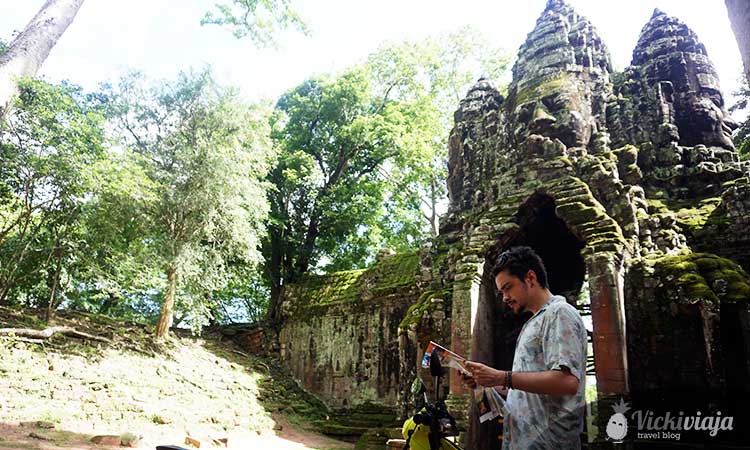
The streets of Siem Reap and Angkor are of much better quality than those of the rest of the country. You might just need some minutes to get used to the busy traffic in Siem Reap.
Bicycle
An alternative might be to go by bike through Angkor. But remember that some of the temples are far off the track. So, it might get a little exhausting. Also, keep in mind how hot the days can get in Cambodia. If you choose the bike anyway, you earn my complete respect!
Our 3-day Angkor Wat Itinerary
To clarify our Angkor map, I have sorted our destinations by day. Each color stands for a different day.
- Day 0: Yellow
- Day 1: Blue
- Day 2: Green
- Day 3: Red
Day O
On the first half day of our tour, let’s just call it Day O, we met our driver, Mr. Chan, at 4.20 pm at the door of our accommodation. We took the tuk-tuk to the building where you can buy your entrance ticket.
After finally obtaining our tickets, we went to Phnom Bakheng to watch the sunset from there. Mr. Chan explained the pros and cons of the different viewpoints, and we decided on this one. We caught our first glimpse of the famous Angkor Wat on the way there and were thrilled.
Sunset at Phnom Bakheng
You can either walk up the Bakheng hill or ride up on an elephant. (But I don’t recommend this, it’s just cruelty to animals. So please don’t).
Once we reached the top, however, we realized that only a certain number of visitors were allowed up at a time. After a short time, it became clear that we would probably not make it to the top for sunset, as most visitors would certainly not come back down until after nightfall.
In the end, however, there were too many clouds for a beautiful sunset, and many visitors came down and cleared the way for those waiting below.

And we could even see the rest of the sunset. Or let’s call it the sun setting into a big bunch of clouds. Anyway, it was nice to see.
Although the complex is not worth standing in line for such a long time during normal daylight, it is totally worth it for sunset. (In high season, you might get much higher chances for a beautiful sunset)
Day 1 of our Angkor 3 Days tour
Angkor Wat

Angkor Wat Facts
- Dedicated to the Hindu God Vishnu
- Built between 1113 and 1150
- Due to missing recordings, the original name of the temple remains unknown
- 1,3 x 1,5 km area
- The highest tower is 65 meters high
- The holes that you can find everywhere in the stones were used to carry around the stones with sticks
A visit to Angkor Wat
We arrived at Angkor Wat on day 1 around 5 am. Still a little sleepy, the sudden glance at the rising sun above the towers of Angkor woke us up immediately. Now, we had to be fast. Our driver, Mr. Chan, accompanied us to the moat surrounding Angkor Wat. Many visitors were already waiting around here, cameras, phones, and selfie sticks everywhere, pointing toward this magnificent act of nature.
Mr. Chan explained to us that we could take even better pictures from inside the temple complex. And he was right.

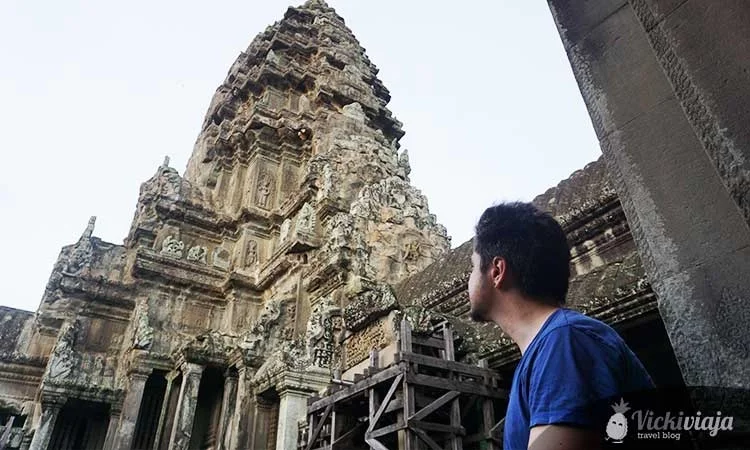
The towers of Angkor Wat are reflected in the small lake you see after entering the temple complex. Don’t worry, you can’t miss it, as there will probably be many visitors here too. Some even walked right into the water to get the best photo perspective. But we managed it without getting our feet wet.
However, no photo can do justice to this view. The sunrise over Angkor Wat is simply breathtakingly beautiful.
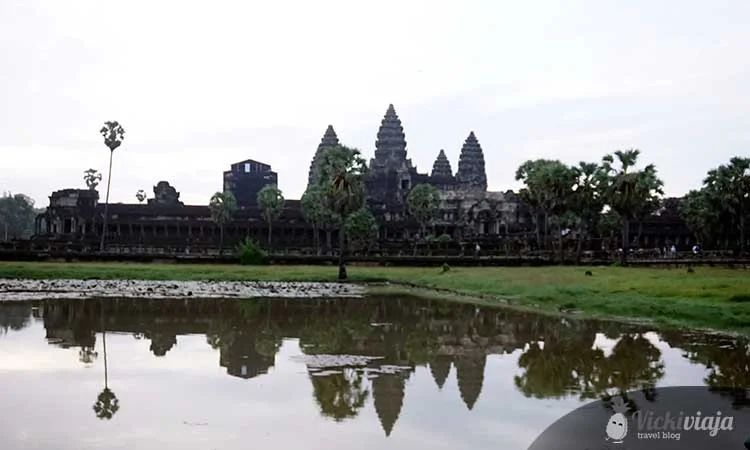

But now let’s get inside quickly before the crowds arrive.
In the end, despite the early hours, there are still many visitors wandering around the ancient corridors of Angkor Wat.
The advantage, however, is that the temple complex is simply so spacious that it doesn’t seem overcrowded.
(Note: Please don’t forget that we were traveling during the rainy season. I can’t promise anything for the high season)


Extra info: In Angkor Wat, it is also not unlikely to meet a monkey or two. So be careful if you are traveling with a plastic bag or any kind of food. The monkeys in Angkor Wat are not afraid of humans and will try anything to get your food.
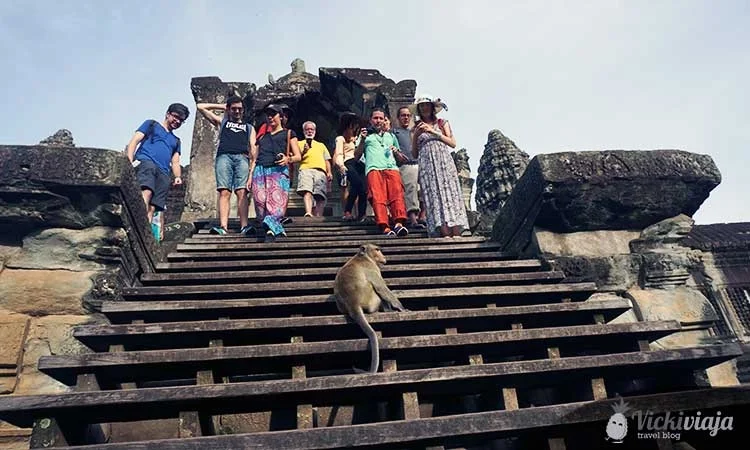

Angkor is simply impressive. We completely lost track of time. I think we spent several hours inside. There is just so much to discover. So make sure you take enough time to explore every last corner of this fascinating temple complex.
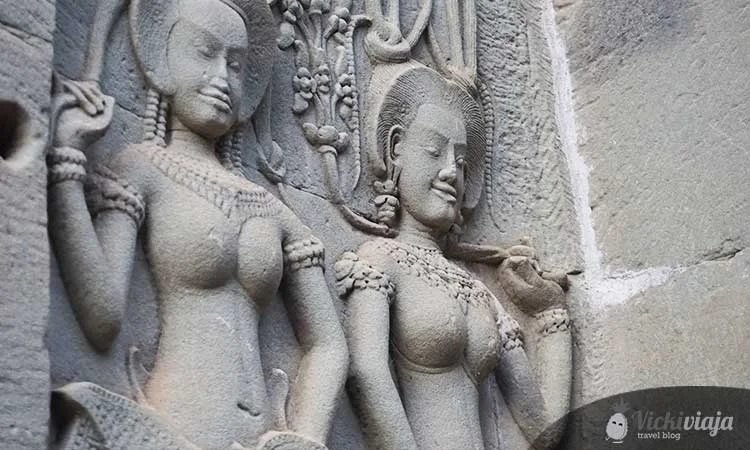

But be prepared for it to be a little bit tiring. There are many steps, and it goes up and down. The temple complex is enormous. Comfortable shoes are, therefore, an absolute advantage here. I even spotted some visitors walking around the temple grounds in high heels.
This attraction has so many visitors, and rightly so. However, I have to admit that, in retrospect, Angkor Wat is not our favorite temple in the entire complex. But more about that now…
Bayon Temple
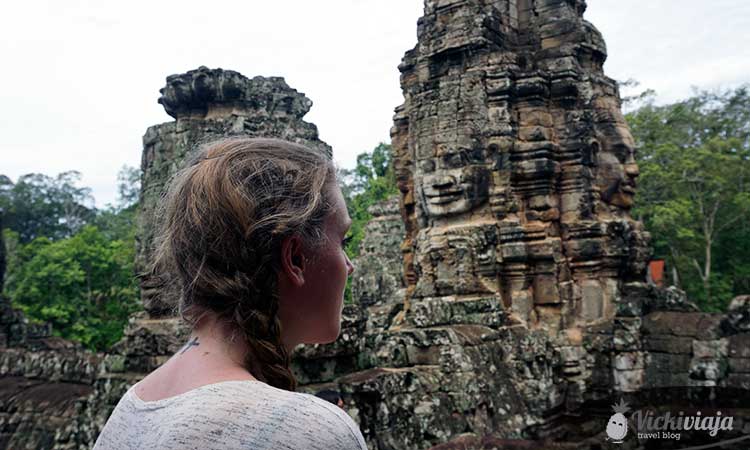
Bayon Facts
- Faces representing Bodhisattva Lokeshvara l
- Buddhist Temple
- The construction started in the 12th Century
- The main temple of the capital, Angkor Thom
A visit in Bayon, Angkor Thom
Bayon immediately mesmerized us and became my favorite temple in Angkor.



The towers with faces here are simply unique. Isn’t it incredible that the details have been preserved over so many years?
However, we were not the only ones fascinated by this unique sight. The Bayon Temple was full of crowds.


However, as we had only booked the short circuit tour for the first day, we were, fortunately, able to stay long enough in the main temple of Angkor Thom to catch the exact spot between two tourist buses that allowed us to take a few lovely photos.
That’s why splitting your visit to Angkor over three days is worth it. This way, you have more time at each temple. With a bit of luck, you’ll have some corners of each temple almost all to yourself. And moments like these are simply magical!
Preah Ang Tang To Pagoda and more small temples

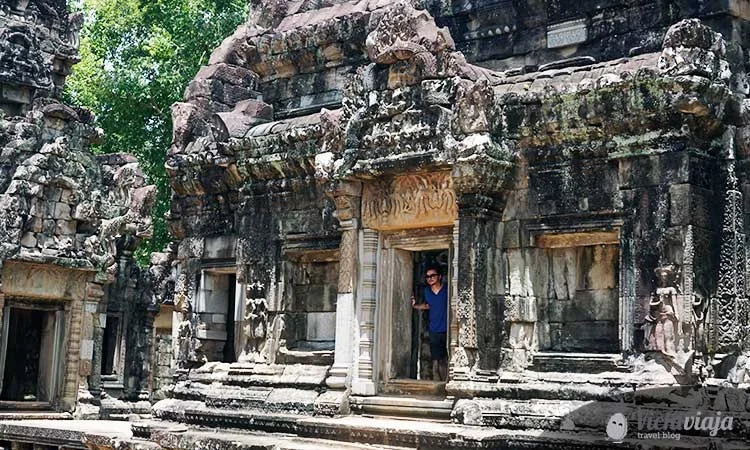
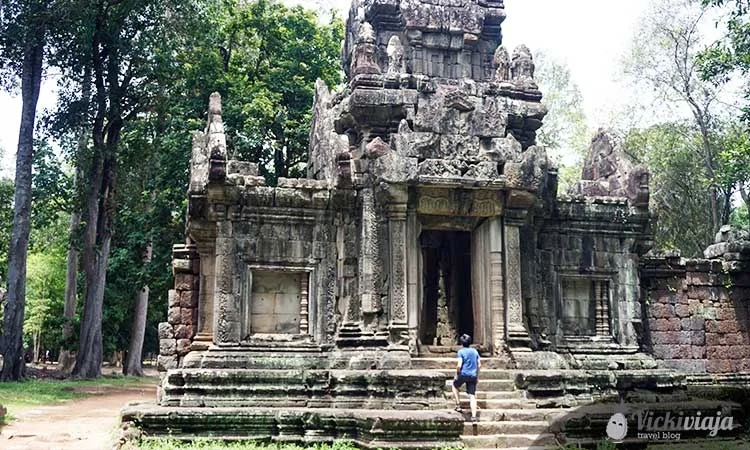
A little hidden, you will find a lot of smaller temples and ruins scattered all over the temple complex of Angkor. So it’s worth wandering around on foot to discover these little hidden places.
If you are traveling with a guide, he can tell you where to find a few temples hidden away from the tourist crowds. We discovered these temples in Angkor Thom.
Ta Prohm (Tomb Raider Temple)
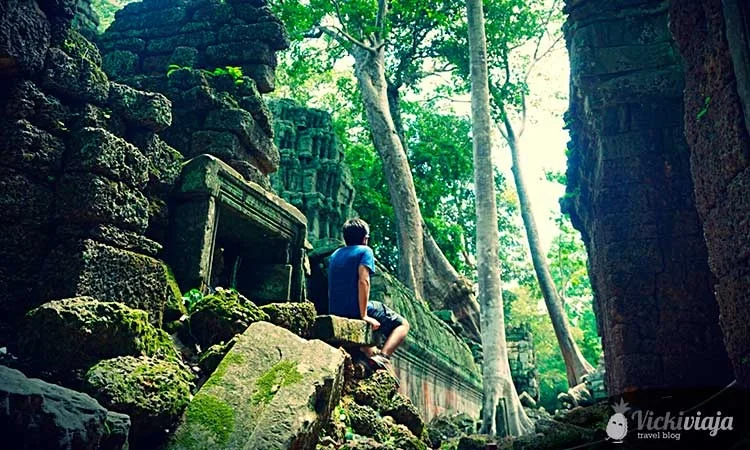

Since Angelina Jolie made this temple famous in Tomb Raider, Angkor and the Ta Prohm temple have been on everyone’s lips. For Eduardo, it even became his favorite temple complex in Angkor.
With its winding corridors and giant trees growing out of the walls of the temple complex, it is a bit like a jungle labyrinth.
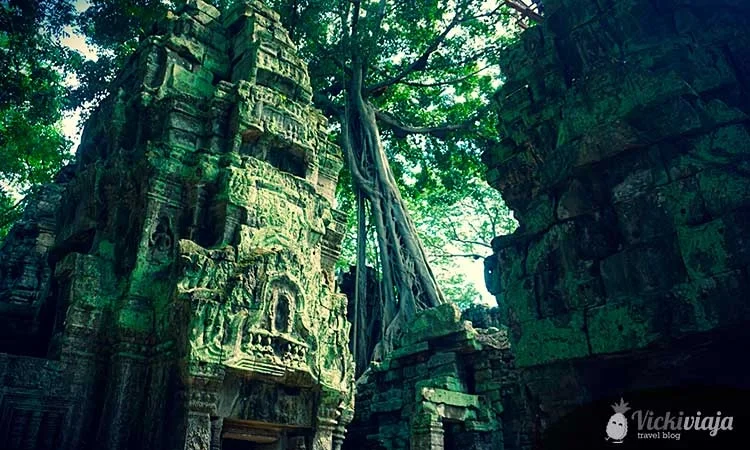
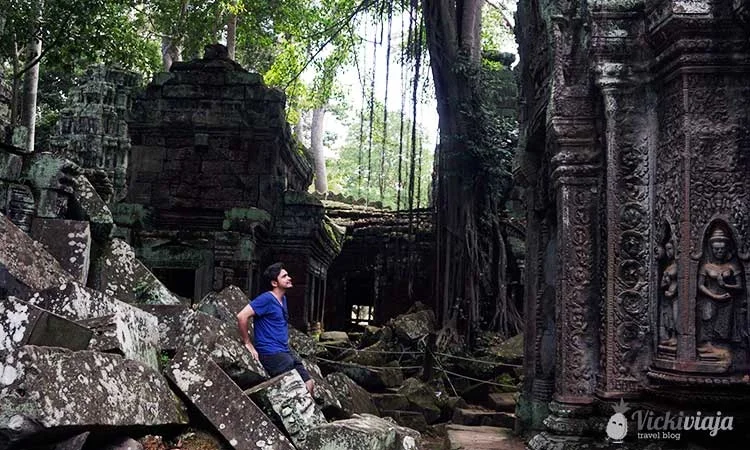

We completely forgot the time while discovering the hidden corners of this temple, but it must have been a good two hours. We didn’t take as many photos in any other temple as in this one.
Every corner offers a new breathtaking spectacle of nature. Simply magnificent.
Day 2 of our Tour through Angkor
On the second day, we continued by scooter. This allowed us more flexibility. However, we are still glad we had our driver, Mr. Chan, who could explain many things about Angkor on the first day.
Victory Gate

Our first stop was the Victory Gate in Angkor. It is located at the northern exit of Angkor Thom.
We stopped briefly to take a quick look at the map (we used maps.me to get our bearings) and take a photo.
We had already seen the arch the day before when we were on the road with our driver, Mr. Chan. He had told us the name of the arch in Spanish: Puerta de Victoria. (That’s probably why I remembered the name so well 😉 )
A short stop here is definitely recommended.
Preah Khan

Preah Khan Facts
- It can be translated to Holy Sword
- Built in the late 12. Century
- Buddhistic Temple
- Barely restored
- Flat temple
A visit to Preah Khan

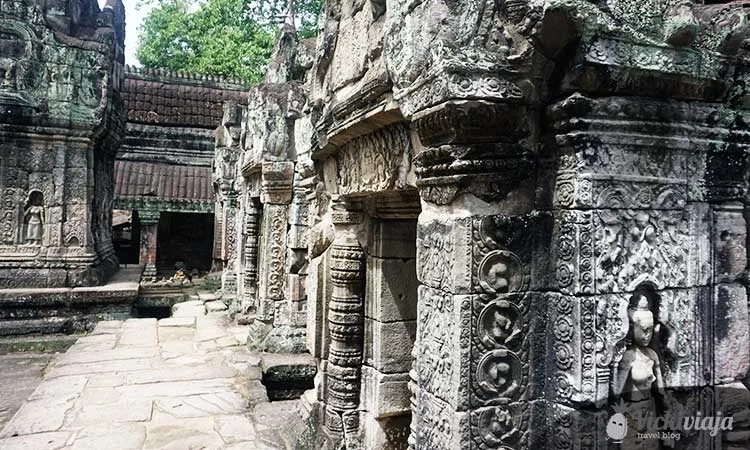
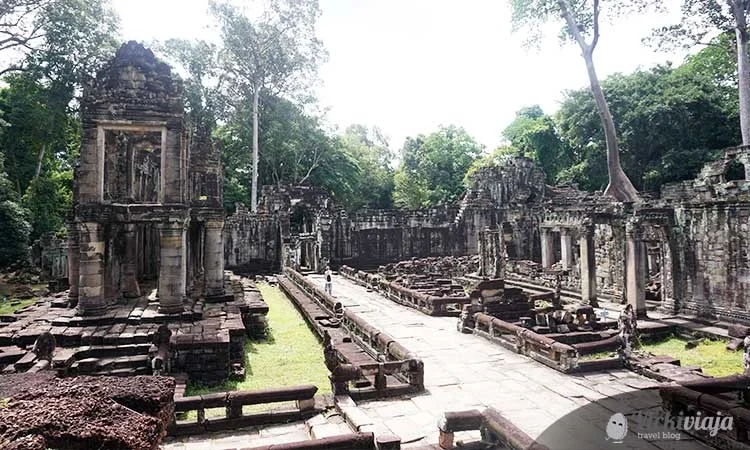
Our first temple on the second day of our Angkor 3-day tour was Preah Khan. After the impressive temples of the first day, this temple actually seemed a little plain in comparison.
Preah Khan has many long corridors with some halls, but it is pretty degraded in many parts.
The advantage, however, was that we didn’t find as many visitors here as at Angkor Wat the day before. Nevertheless, the temple didn’t really stand out from the rest.
Neak Pean

Neak Pean Facts
- Its name can be translated as Interwinted Snakes
- Artificial island
- Built at the end of the 12th. Century
- 350 x 350 area
- The temple itself is supposed to represent a Lotus bud
A visit to Neak Pean

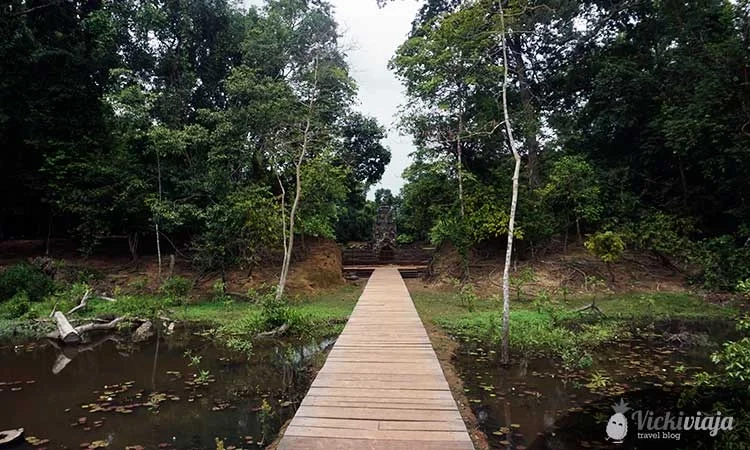

Another standout moment of our trip was visiting Neak Pean. The temple may not be the most striking, but the journey to it, crossing a swamp, is awe-inspiring in its own right.
A heavy thunderstorm rolled in as we made our way there — a typical welcome from the rainy season! But the dark clouds gathering over the swamp created a stunning view.
I believe that Neak Pean, or more specifically, its surrounding swamp, is absolutely worth a visit, even in good weather.
Ta Som

Ta Som Fakten
- Built between 1190- 1210
- Flat temple
- It is also described as the simple mini version of the Ta Prohm Temple
- Translated, the name would be something along the lines of Ancestor Som and is dedicated to the Mentor of the former king
- The original name was Gaurashrigajaratna, which can be roughly translated to Jewel of the Fortune bringing white elephant
A visit to Ta Som
Let’s get to another beautiful temple with a lot to discover. However, the rain made it difficult for us to walk around, which is why we spent more time inside.
What made this temple special was the jungle feeling created by the combination of old walls and the trees and plants growing out of them.

We will never forget the Ta Som temple for its cute little resident: a cat. We had made so many friends with cats during our trip, but we still enjoyed every single one we met. (As I write these lines, a cat is lying on my lap, escaping the rain on our terrace). We spent 20 minutes with the kitty and an Indian family who had also joined the cat while we sheltered from the rain.
East Mebon

East Mebon Facts
- Opened in 952
- Dedicated to the Hindu God Shiva
- The temple used to be surrounded by a moat and could only be reached by boat
A visit to East Mebon
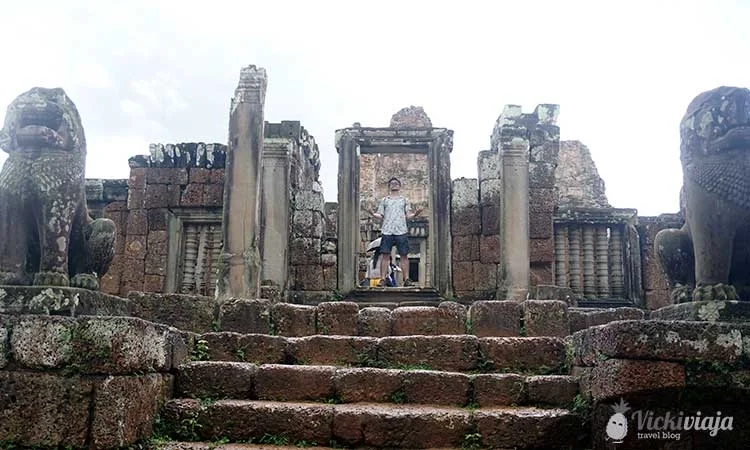

The East Mebon Temple is extensive and impressive. Its architecture reminded us a little of Angkor Wat (According to the facts, however, it is architecturally more similar to the Pre Rup temple).
In the East Mebon, you will find some impressive elephant statues. However, most of them are no longer complete. The statues are up to two meters high.
It is noticeable that comparatively few visitors come here, which creates a quieter atmosphere for exploring the temple.
Although the East Mebon was not one of our highlights, it is still worth a visit.
Banteay Samré

Banteay Samré Facts
- The name can be translated to Fortress of the Samré
- The Samré was a tribe which used to live in this area
- Shows mainly Hindu reliefs but also Buddhist ones
- Built in the first half of the 12. Century
A visit to Banteay Samré
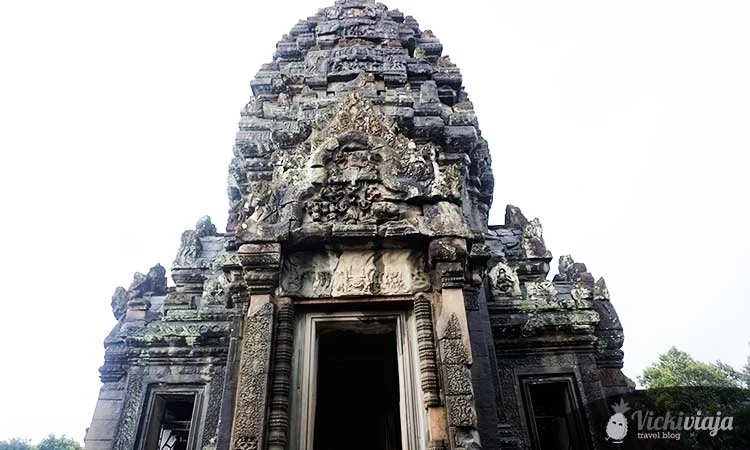
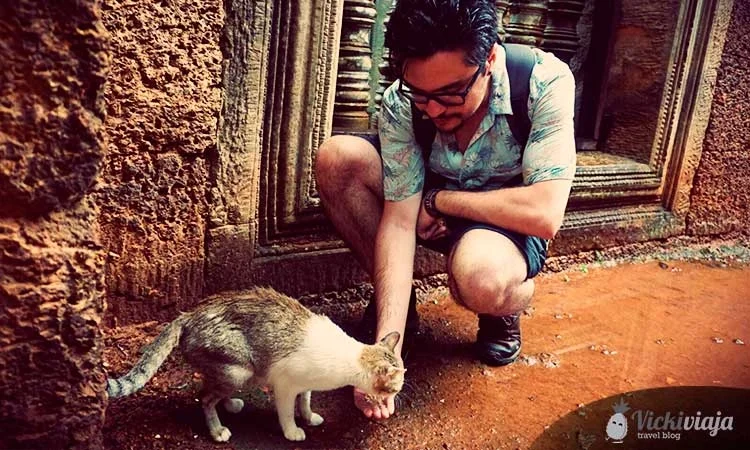

One of the great things about Banteay Samré temple is its relative obscurity in most tours. As a result, it’s peaceful, allowing for a more serene exploration.
In terms of design, the temple closely mirrors Angkor Wat, offering a similar vibe but without the crowds. Sounds appealing, right?
Our visit to Banteay Samré was quite rainy, too. Here, we encountered a cat, which made Eduardo stop for a while in a spot where we had limited room to move without getting wet. It took almost ten minutes before he was ready to leave the cat behind so we could find a drier spot.
Pre Rup

Pre Rup Facts
- Built in the 10th Century
- Hindu Temple
- Dedicated to the god Shiva
- Served as a model for Angkor Wat
- Three-staged Pyramid
- 12 Meter high
A visit to Pre Rup


The Pre Rup temple was the highlight of our day. The temple is built like a pyramid and, therefore, offers a wonderful panoramic view. However, the many steps to the top can be a bit tiring on such a long day. But trust me, the way up is worth every step. Because at the top, you are rewarded with an incomparable view.
We liked the Pre Rup temple so much that we even returned to it on the third day of our visit to Angkor.
Banteay Kdei

Banteay Kdei Facts
- Built from the middle of the 12th Century until the beginning of the 13th. Century
- Buddhist Temple
- Translated to Citadel of chambers
- Gets restored recently
A visit to Banteay Kdei

Our stay at Banteay Kdei can be summed up in one word: Monsoon rain. While we had arrived in light sunshine, the weather quickly changed. First, however, we had a little time to explore the temple.

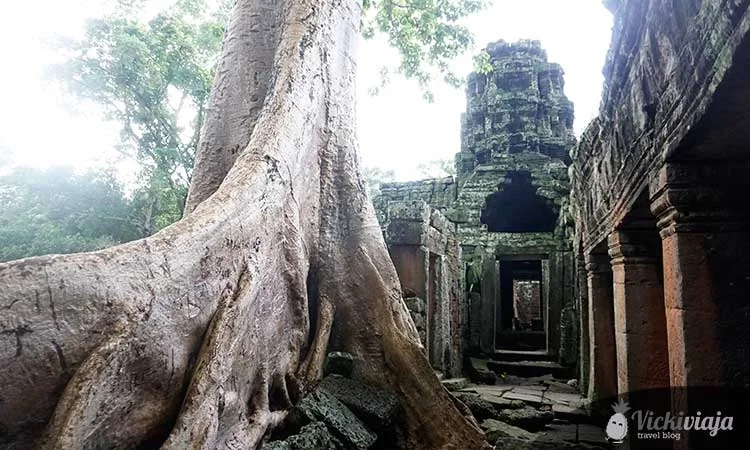
What sets this temple apart are the massive trees that emerge from the ancient walls. They’re simply stunning. Standing beside them, you can’t help but feel a sense of awe at their size and beauty.


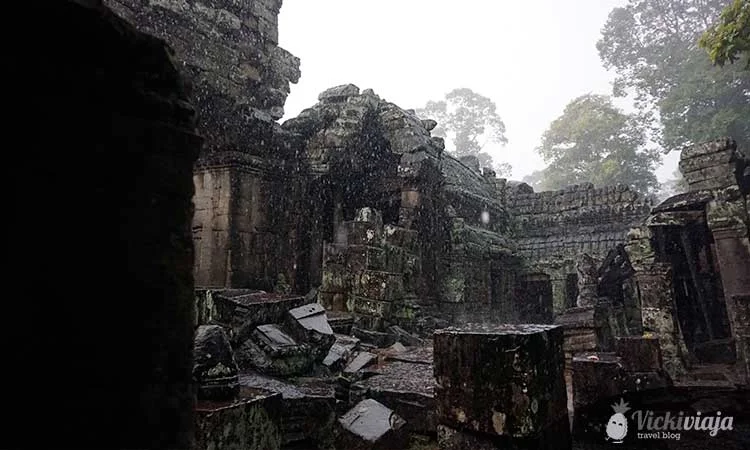
When the rain started, we were on the far side of the temple, so we had to walk through it to get to the exit. It was almost 5:30 PM, and we remembered a sign saying the temple closed at 5 PM. Eventually, we ventured through the rain towards the exit.
We encountered an employee taking shelter, who told us the temple was closed but didn’t mind us being there. Luckily, we could walk past the entrance barrier – we had briefly worried about spending the night in the temple!
And, in typical fashion, as soon as we reached the exit, drenched, the rain stopped.
Angkor Day 3
Banteay Srei

Banteay Srei Facts
- Hindu Temple
- The translated name is Citadel of Women/Beauty
- Dedicated 2/3 to Shiva and 1/3 to Vishnu
- Built in the middle of the 10. Century
- 3 Temple towers
- The original name was Tribhuvanamahesvara, which can be translated to Great God of the Trinitarian World
A visit to Banteay Srei
The Banteay Srei temple was recommended to us several times. However, it is located 53 km/33 mi outside Siem Reap. Full of expectations, we set off on the 1 1/2-hour drive to the Banteay Srei complex.
With a few exceptions, the journey was relatively easy. After we mastered a wholly flooded road and a snake fell from a tree right in front of us, we had no further problems. However, it should be noted that the quality of the roads deteriorates significantly the further you get from Angkor Wat.
Nevertheless, the road is also suitable for less experienced drivers.

We hoped for a temple without the crowds. After all, who was like us and would embark on such a long journey just to see a temple, right?
As soon as we reached the vast parking lot of Banteay Srei, we knew the answer: coaches full of tourists.
In fact, the whole complex was full of tourists. We were surprised by a tourist information desk right at the entrance. So much for a quiet and remote temple… You had to wade through many souvenir stores and overpriced restaurants to get to the temple.
And the temple…?

…was definitely not worth such a long journey. We were very disappointed. Not only was the temple small and overcrowded, it also didn’t have many details. And all the way here for that? In the end, we only spent a good ten minutes inside.
There is a small park around the temple. You can hire a boat to sail around the lake. However, the prices in the entire complex cannot be compared with those in the rest of the country: Everything was somehow overpriced.
The only interesting thing was a small exhibition where you could learn more about the history of Angkor, from its discovery to the present day.
The surroundings of Angkor

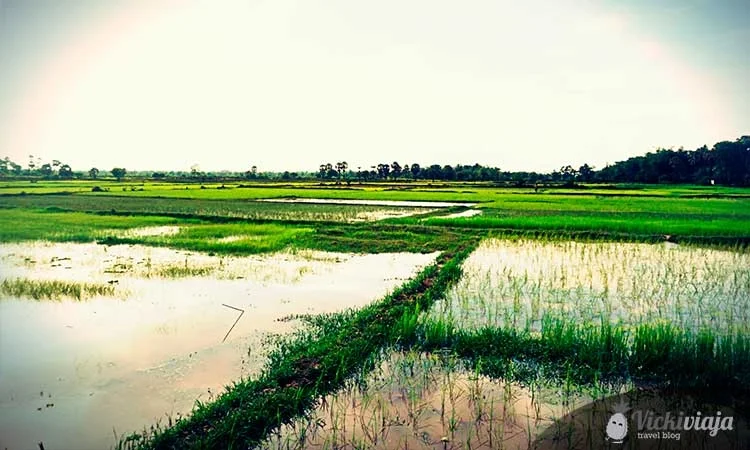

When you visit the Angkor Archaeological Park, you can observe temples and beautiful nature, from rice fields and lakes to local life. Just keep your eyes open during your trip.
Pre Rup
As mentioned before, we returned to the Pre Rup on our third day. This time, we had better weather, so we had the chance to get an even better view than the previous day.
Preah Ko

Preah Ko Facts
- Built in the late 9. Century
- Belongs to the Roluos Temple Group
- Hindu Temple
- Dedicated to the god Shiva
- It consists of 6 tower buildings
- The name can be translated to Temple of the holy ox
A visit to Preah Ko
Preah Ko and the following two temples are both located a little outside the Angkor Archaeological Park. After a drive in the blazing sun, we were glad to have finally arrived.
Even though the towers are impressive, there is not much else to discover at this temple complex. So don’t plan too much time for your visit.
It can get boiling while exploring the temple, as there is little shade on the platform where the towers are located. So make sure to bring sunscreen.
Bakong

Bakong Facts
- Built in the second half of the 9. Century
- Belongs to the Roluos Temple Group
- Hindu Temple
- Dedicated to the god Shiva
- The first temple pyramid of that kind
- Surrounded by a moat
A visit to Bakong
We hadn’t originally planned to visit Bakong Temple. But as we were driving around, we spotted its towering structures beyond the moat encircling the temple, creating a truly picturesque scene. We were immediately drawn to see the temple up close.
The only catch was the approach – the road leading to it isn’t paved, making for a somewhat bumpy journey.

We were thrilled to stumble upon another temple like this at the end of our 3-day Angkor trip. It was pleasantly uncrowded, allowing us to explore at our leisure.
Not to mention, the temple offers a fantastic view.
Lolei
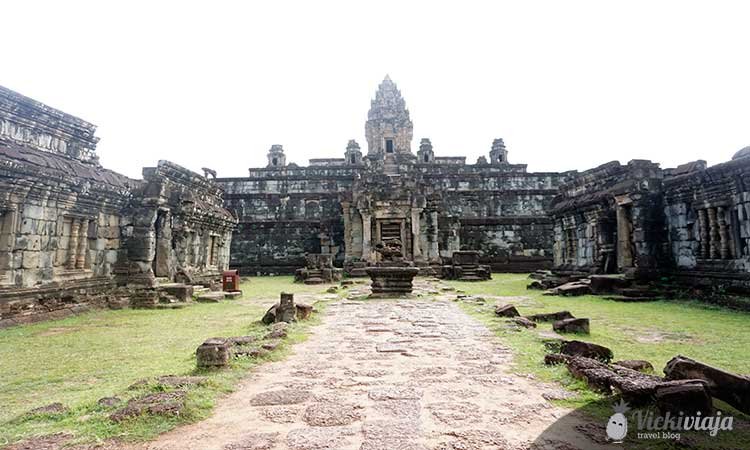
Lolei Facts
- Opened on the 08. July 893
- Belongs to the Roluos Temple Group
- Just 2 of the original four tours remained
A visit to the Lolei Temple
The Lolei Temple gave us a perfect end to our Angkor tour. And we were delighted to have come here. The temple is not really big, so you don’t need much time to look around.
But what we discovered next to the temple was almost more interesting. There was a school where children and monks were taught free of charge.
We met one of the teachers who works here without pay. He is not actually a teacher yet because when he is not teaching, he is still at university. However, at this school, he teaches English.

We talked with him about how important education is and how you can get motivated to learn English. It saddens us to know that it’s not a habit in this country that every child goes to school.
So, if you are around the Lolei temple, feel free to make a little donation so that the children of Siem Reap can learn English.

Best time to visit Angkor Wat
High season
End of October – April
Raining Season
May – October
How to get to Siem Reap
From Phnom Penh
From Phnom Penh, it’s easiest to get to Siem Reap by bus. The bus ride can be between 7 and 10 hours, depending on the weather and road conditions – and can be pretty shaky. Anyway, it’s the cheapest option to travel between the two important cities in Cambodia.
You can get your ticket on-site or online here.
From Bangkok
Many people visit the impressive sight of Angkor from Thailand. To get from Bangkok to Siem Reap, you basically have the option to go by bus or by airplane.
While the airplane might be the fastest option and great for everyone who only has a little time at hand, going by bus is usually way cheaper and better for the environment. You can get your ticket on-site or online here.
Dress Code
It is obligatory (especially for a woman) to have your clothes cover everything up to your knees and shoulders. This is not only a matter of respect but also is getting checked in front of every temple.
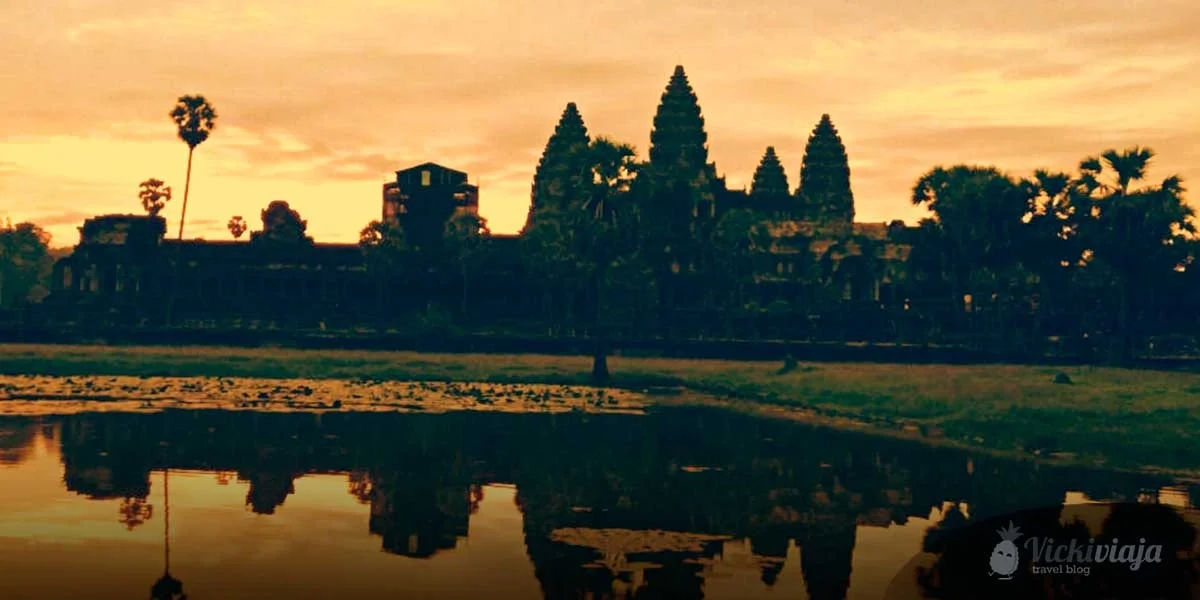




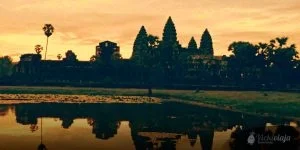





Very detailed post with beautiful pictures. Your post reminded me of my trip.
Thank you. I hope it was a nice memory you made there 🙂
An enjoyable read, as is the second part of your tour. The pictures look so atmospheric, you did well to get the snaps before all the other tourists arrived. I haven’t been to Cambodia yet but this blog post is very inspiring.
Cambodia is an amazing country. I can just recommend you to go 🙂
Nice pics.. Well detailed out. A couple of questions.. How much would be the daily expense we would need to consider?
Is vegetarian food easily available?
Please do check out our blog too
Basically, it would just be the rent for a scooter or the price of the tuk-tuk driver. You can find food for around $1-3 per Person per meal.
And yes, you can also find vegetarian food 🙂
We are planning a trip to Cambodia real soon and we can’t wait! This is a really good itinerary and we will be keeping it in mind for our trip. Thanks for sharing.
Hi Campbell,
Thank you for your comment! I am happy you like the itinerary and I hope it’s useful for you when you are in Cambodia. We have a lot more Cambodia content. Feel free to check it out. Have a great trip! 🙂